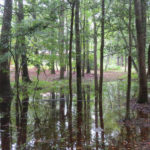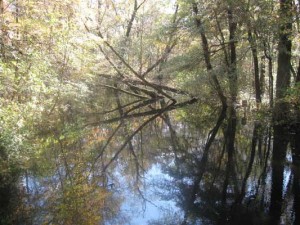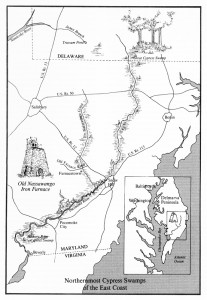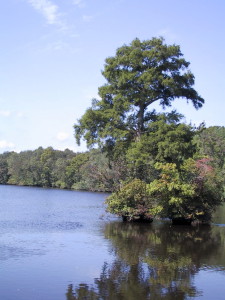Woodlands
Botanically speaking, woodlands are forests that tend to flood in times of heavy rains. Little of this area on Maryland’s Eastern Shore is far above sea level, and the Pocomoke River and its attendant creeks and swamps are a sponge for seasonal rains. Much of the forest is nearly impassable with treacherous bogs and swamps, brambles and stump holes. This inaccessibility has helped to protect the delicate wildflowers and shy birds who live there.
The Pocomoke River watershed on Maryland’s Eastern Shore is an area of cypress and oak, warblers and wildflowers. The Nassawango Creek is the longest tributary of the Pocomoke River. It winds through a swampy forest for almost 20 miles through a thick maze of plant growth. These swamps help to slow flood water after heavy rains by slowly filtering rainwater that drains from fields and ditches. The health of the Chesapeake Bay depends on these and other forests to provide nature’s water cleaning system.
Because it flows into the Chesapeake Bay and is a very deep river, the Pocomoke River was explored in the late 17th century by John Smith and others. The town of Snow Hill was established in 1642 and the area was settled long before more inland locations.
The swamps of the Pocomoke watershed are as far north as bald cypress trees grow. The mild coastal climate and bottom land soils mimic the more southern swamps that are favored by cypress. To survive constant inundation by water, the bald cypress has evolved special root growths called knees. Many visitors seeing the knees for the first time ask if they are stunted or deformed trees, but they are important to the parent tree. Cypress knees reach above the water and saturated soil to provide the roots with essential oxygen which otherwise would not be available in the flooded soil.
Cypress knees usually grow as tall as the average flood water height. In some parts of the swamp they are 4 or 5 feet tall. the cypress tree, which rises high above the forest may reach a height of 150 feet and live for hundreds of years. The tree itself has a tall straight trunk and a wide base and reddish brown bark. The feather-like leaves are actually needles. Although baldcypress bears cones like a pine tree, it drops its needles every fall and becomes ‘bald’.




